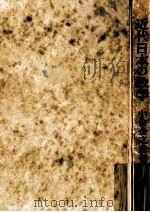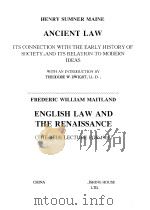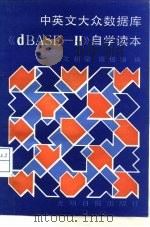《大学代数 英文本》
| 作者 | 编者 |
|---|---|
| 出版 | 徐氏基金会 |
| 参考页数 | 638 |
| 出版时间 | 没有确切时间的资料 目录预览 |
| ISBN号 | 无 — 求助条款 |
| PDF编号 | 815376858(仅供预览,未存储实际文件) |
| 求助格式 | 扫描PDF(若分多册发行,每次仅能受理1册) |

PREFACE15
PART Ⅰ:SET THEORY19
0.Logical reasoning20
1.The concept of logical perfection20
2.The real language of mathematics22
3.Elementary logical operations24
4.Axioms and theorems25
5.Logical axioms and tautologies26
6.Substitution in a relation30
7.Quantifiers31
8.Rules for quantifiers32
9.The Hilbert operation.Criteria of formation35
Exercises on 038
1.The relations of equality and membership41
1.The relation of equality41
2.The relation of membership42
3.Subsets of a set43
4.The empty set45
5.Sets of one and two elements46
6.The set of subsets of a given set47
Exercises on 149
2.The notion of a function50
1.Ordered pairs50
2.The Cartesian product of two sets51
3.Graphs and functions53
4.Direct and inverse images56
5.Restrictions and extensions of functions57
6.Composition of mappings58
7.Injective mappings61
8.Surjective and bijective mappings62
9.Functions of several variables65
Exercises on 268
3.Unions and intersections70
1.The union and intersection of two sets70
2.The union of a family of sets71
3.The intersection of a family of sets72
Exercises on 375
4.Equivalence relations77
1.Equivalence relations77
2.Quotient of a set by an equivalence relation79
3.Functions defined on a quotient set82
Exercises on 486
5.Finite sets and integers88
1.Equipotent sets88
2.The cardinal of a set89
3.Operations on cardinals92
4.Finite sets and natural numbers95
5.The set N of the natural numbers96
6.Mathematical induction98
7.Combinatorial analysis99
8.The rational integers102
9.The rational numbers107
Exercises on 5108
PART Ⅱ:GROUPS,RINGS,FIELDS113
6.Laws of composition114
1.Laws of composition;associativity and commutativity114
2.Reflexible elements117
7.Groups120
1.Definition of a group.Examples120
2.Direct product of groups122
3.Subgroups of a group124
4.The intersection of subgroups.Generators127
5.Permutations and transpositions129
6.Cosets130
7.The number of permutations of n objects133
8.Homomorphisms134
9.The kernel and image of a homomorphism136
10.Application to cyclic groups138
11.Groups operating on a set139
Exercises on 7142
8.Rings and fields148
1.Definition of a ring.Examples148
2.Integral domains and fields151
3.The ring of integers modulo p153
4.The binomial theorem154
5.Expansion of a product of sums157
6.Ring homomorphisms158
Exeroises on 8160
9.Complex numbers168
1.Square roots168
2.Preliminaries168
3.The ring K[?]169
4.Units in a quadratic extension172
5.The case of a field174
6.Geometrical representation of complex numbers175
7.Multiplication formulae for trigonometric functions178
Exercises on 9181
PART Ⅲ:MODULES OVER A RING187
10.Modules and vector spaces188
1.Definition of a module over a ring188
2.Examples of modules189
3.Submodules;vector subspaces191
4.Right modules and left modules192
11.Linear relations in a module194
1.Linear combinations194
2.Finitely generated modules196
3.Linear relations196
4.Free modules.Bases198
5.Infinite linear combinations201
Exercises on 10 and 11203
12.Linear mappings.Matrices208
1.Homomorphisms208
2.Homomorphisms of a finitely generated free module into an arbitrary module210
3.Homomorphisms and matrices212
4.Examples of homomorphisms and matrices215
13.Addition of homomorphisms and matrices220
1.The additive group Hom(L,M)220
2.Addition of matrices221
1.The ring of endomorphisms of a module223
14.Products of matrices223
2.The product of two matrices224
3.Rings of matrices226
4.Matrix notation for homomorphisms228
Exercises on 12,13 and 14230
15.Invertible matrices and change of basis235
1.The group of automorphisms of a module235
2.The groups GL(n,K)235
3.Examples:the groups GL(1,K)and GL(2,K)236
4.Change of basis.Transition matrices238
5.Effect of change of bases on the matrix of a homomorphism241
Exercises on 15244
16.The transpose of a linear mapping249
1.The dual of a module249
2.The dual of a finitely generated free module250
3.The bidual of a module252
4.The transpose of a homomorphism254
5.The transpose of a matrix255
Exercises on 16259
17.Sums of submodules261
1.The sum of two submodules261
2.Direct product of modules262
3.Direct sum of submodules263
4.Direct sums and projections265
Exercises on 17268
PART Ⅳ:FINITE-DIMENSIONAL VECTOR SPACES271
1.Homomorphisms whose kernel and image are finitely generated272
18.Finiteness theorems272
2.Finitely generated modules over a Noetherian ring273
3.Submodules of a free module over a principal ideal domain274
4.Applications to systems of linear equations275
5.Other characterizations of Noetherian rings277
Exercises on 18279
19.Dimension282
1.Existence of bases282
2.Definition of a vector subspace by means of linear equations284
3.Conditions for consistency of a system of linear equations285
4.Existence of linear relations287
5.Dimension289
6.Characterizations of bases and dimension291
7.Dimensions of the kernel and image of a homomorphism292
8.Rank of a homomorphism;rank of a family of vectors;rank of a matrix294
9.Computation of the rank of a matrix295
10.Calculation of the dimension of a vector subspace from its equations298
Exercises on 19300
20.Linear equations306
1.Notation and terminology306
2.The rank of a system of linear equations.Conditions for the existence of solutions307
3.The associated homogeneous system308
4.Cramer systems308
5.Systems of independent equations:reduction to a Cramer system310
Exercises on 20313
PART Ⅴ:DETERMINANTS317
1.Definition of multilinear mappings318
21.Multilinear functions318
2.The tensor product of multilinear mappings321
3.Some algebraic identities323
4.The case of finitely generated free modules326
5.The effect of a change of basis on the components of a tenso?333
Exercises on 21336
22.Alternating bilinear mappings341
1.Alternating bilinear mappings341
2.The case of finitely generated free modules342
3.Alternating trilinear mappings345
4.Expansion with respect to a basis346
Exercises on 22350
23.Alternating multilinear mappings353
1.The signature of a permutation353
2.Antisymmetrization of a function of several variables357
3.Alternating multilinear mappings359
4.Alternating p-linear functions on a module isomorphic to Kp361
5.Determinants362
6.Characterization of bases of a finite-dimensional vector space366
7.Alternating multilinear mappings:the general case369
8.The criterion for linear independence371
9.Conditions for consistency of a system of linear equations373
Exercises on 23376
24.Determinants380
1.Fundamental properties of determinants380
2.Expansion of a determinant along a row or column382
3.The adjugate matrix386
4.Cramer's formulae387
Exercises on 24390
25.Affine spaces396
1.The vector space of translations396
2.Affine spaces associated with a vector space397
3.Barycentres in an affine space399
4.Linear varieties in an affine space402
5.Generation of a linear variety by means of lines405
6.Finite-dimensional affine spaces.Affine bases406
7.Calculation of the dimension of a linear variety408
8.Equations of a linear variety in affine coordinates410
PART Ⅵ:POLYNOMIALS AND ALGEBRAIC EQUATIONS413
26.Algebraic relations414
1.Monomials and polynomials in the elements of a ring414
2.Algebraic relations416
3.The case of fields417
Exercises on 26420
1.Preliminaries on the case of one variable423
27.Polynomial rings423
2.Polynomials in one indeterminate424
3.Polynomial notation426
4.Polynomials in several indeterminates428
5.Partial and total degrees429
6.Polynomials with coefficients in an integral domain430
28.Polynomial functions432
1.The values of a polynomial432
2.The sum and product of polynomial functions433
3.The case of an infinite field435
Exercises on 27 and 28438
1.The field of fractions of an integral domain:preliminaries446
29.Rational fractions446
2.Construction of the field of fractions447
3.Verification of the field axioms450
4.Embedding the ring K in its field of fractions451
5.Rational fractions with coefficients in a field452
6.Values of a rational fraction454
Exercises on 29458
1.Derivations of a ring463
30.Derivations.Taylor's formula463
2.Derivations of a polynomial ring464
3.Partial derivatives466
4.Derivation of composite functions467
5.Taylor's formula468
6.The characteristic of a field470
7.Multiplicities of the roots of an equation471
Exercises on 30475
1.Highest common factor479
31.Principal ideal domains479
2.Coprime elements480
3.Least common multiple481
4.Existence of prime divisors482
5.Properties of extremal elements484
6.Uniqueness of the decomposition into prime factors485
7.Calculation of h.c.f.and l.c.m.by means of prime factorization486
8.Decomposition into partial fractions over a principal ideal domain488
Exercises on 31491
32.Division of polynomials497
1.Division of polynomials in one variable497
2.Idealsin a polynomial ring in one iadeterminate500
3.The h.c.f.and l.c.m.of several polynomials.Irreducible polynomials501
4.Application to rational fractions503
Exercises on 32506
33.The roots of on algebraic equation515
1.The maximum number of roots515
2.Algebraically closed fields517
3.Number of roots of an equation with coefficients in an algebraically closed field519
4.Irreducible polynomials with coefficients in an algebraically closed field521
5.Irreducible polynomials with real coefficients522
6.Relations between the coefficients and the roots of an equation524
Exercises on 33526
PART Ⅶ:REDUCTION OF MATRICES537
34.Eigenvalues538
1.Definition of eigenvectors and eigenvalues538
2.The characteristic polynomial of a matrix539
3.The form of the characteristic polynomial540
4.The existence of eigenvalues541
5.Reduction to triangular form541
6.The case in which all the eigenvalues are simple545
7.Characterization of diagonalizable endomorphisms548
Exercises on 34551
35.The canonical form of a matrix565
1.The Cayley-Hamilton theorem565
2.Decomposition into nilpotent endomorphisms567
3.The structure of nilpotent endomorphisms569
4.Jordan's theorem572
Exercises on 35575
36.Hermitian forms583
1.Sesquilinear forms;hermitian forms583
2.Non-degenerate forms586
3.The adjoint of ahomomorphism588
4.Orthogonality with respect to a non-degenerate hermitian form591
5.Orthogonal bases596
6.Orthonormal bases598
7.Automorphisms of a hermitian form600
8.Automorphisms of a positive definite hermitian form.Reduction to diagonal form602
9.Isotropic vectors and indefinite forms606
10.The Cauchy-Schwarz inequality607
Exercises on 36610
BIBLIOGRAPHY622
INDEX OF NOTATION626
INDEX OF TERMINOLOGY629
《大学代数 英文本》由于是年代较久的资料都绝版了,几乎不可能购买到实物。如果大家为了学习确实需要,可向博主求助其电子版PDF文件(由 徐氏基金会 出版的版本) 。对合法合规的求助,我会当即受理并将下载地址发送给你。
高度相关资料
-

- 大学英文选
- 1987 北京:外语教学与研究出版社
-

- 大学英文选
- 1947
-

- 近代日本の数学
- 1956.07 新樹社
-

- 大学基本英作文
- 1981.09 北星堂書店
-

- 近代日本の数学
- 1979.01 講談社
-

- 离散数学 英文
- 1999 北京/西安:世界图书出版公司
-

- 古代法 英文本 英文本
- 1999 中国社会科学出版社
-

- 大学一年级英文教本
- 北京:商务印书馆
-

- 代数学基本结构
- 1973 徐氏基金会
-

- 代数课本
- 1953 工人出版社
-

- 大学文科数学
- 1999 天津:天津大学出版社
-

- 大学英语教学大纲 英文版
- 1991 上海:上海外语教育出版社
-

- 中英文大众数据库《dBASE-Ⅱ》自学读本
- 1987 北京:光明日报出版社
-

- 现代大学英语
- 1995 北京:化学工业出版社
提示:百度云已更名为百度网盘(百度盘),天翼云盘、微盘下载地址……暂未提供。➥ PDF文字可复制化或转WORD
